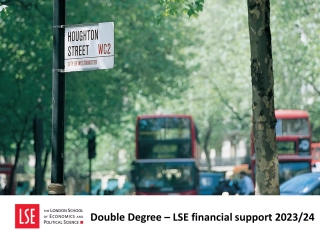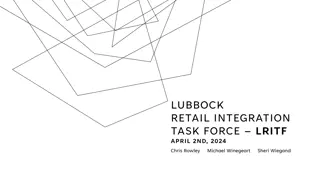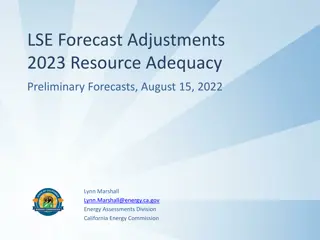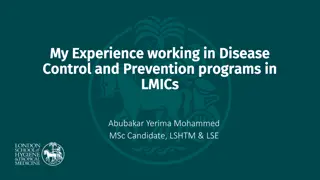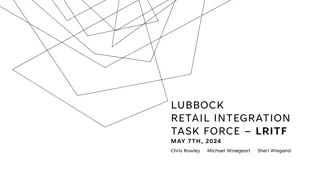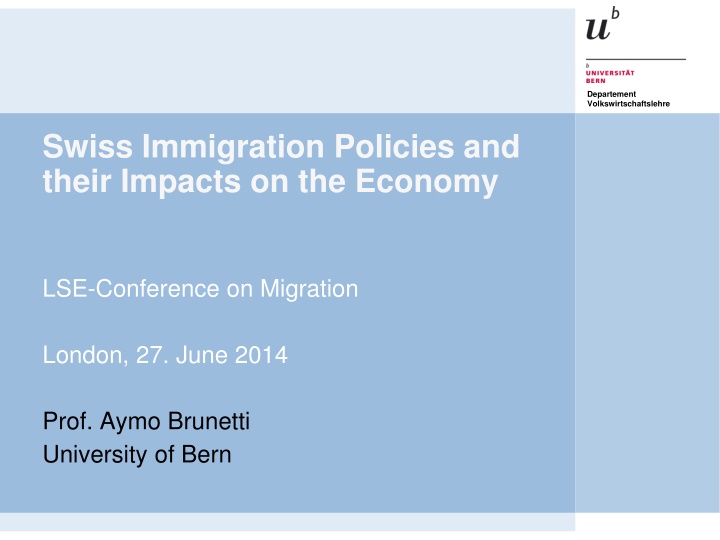
Swiss Immigration Policies and Their Economic Impacts
Explore the effects of Swiss immigration policies on the economy through a discussion on numerical data, policy regimes, and their consequences. Learn about historical immigration trends and the shift in regimes over the years, shedding light on the different approaches to managing immigration in Switzerland.
Download Presentation

Please find below an Image/Link to download the presentation.
The content on the website is provided AS IS for your information and personal use only. It may not be sold, licensed, or shared on other websites without obtaining consent from the author. If you encounter any issues during the download, it is possible that the publisher has removed the file from their server.
You are allowed to download the files provided on this website for personal or commercial use, subject to the condition that they are used lawfully. All files are the property of their respective owners.
The content on the website is provided AS IS for your information and personal use only. It may not be sold, licensed, or shared on other websites without obtaining consent from the author.
E N D
Presentation Transcript
Departement Departement Volkswirtschaft Volkswirtschaftslehre Swiss Immigration Policies and their Impacts on the Economy LSE-Conference on Migration London, 27. June 2014 Prof. Aymo Brunetti University of Bern
Content Departement Departement Volkswirtschaft Volkswirtschaftslehre 1. Some Numbers 2. Swiss Immigration Policy Regimes 3. Economic Effects of Free Movement of Labor 4. Regime Change 2014 5. Conclusions 2
1. Some Numbers Departement Departement Volkswirtschaft Volkswirtschaftslehre > An high share of foreign born people in Switzerland: USA: 12.9% (2010) Canada: 19.5% (2006) Australia: 26.8% (2010) Switzerland: 27.6% (2012) 3
1. Some Numbers Departement Departement Volkswirtschaft Volkswirtschaftslehre > A strong recent increase of immigration: Average immigration 1982 2002: 90 000 per year 2002 2012: 120 000 per year the population of Bern Average balance of migration 1982 2002: 25 000 per year 2002 2012: 60 000 per year 4
1. Some Numbers Departement Departement Volkswirtschaft Volkswirtschaftslehre Source: Swiss Federal Statistical Office 5
2. Swiss Immigration Regimes Departement Departement Volkswirtschaft Volkswirtschaftslehre > The Regime between 1970 and 2002 Numerical limits for specific groups of migrants > The Regime between 2002 and 2014 Free movement of persons > The Regime after 2014 Numerical limits for all groups of migrants 6
2. Swiss Immigration Regimes Departement Departement Volkswirtschaft Volkswirtschaftslehre The Regime between 1970 and 2002: > Quotas per economic sector > Allocation politically decided => High quotas for agriculture and low-skilled jobs > Consequence: Low-skilled immigration => After some years: Inefficient reallocation (see next slide) 7
The Regime Between 1970 and 2002 Demand Driven Numerical Limits Departement Departement Volkswirtschaft Volkswirtschaftslehre Medium- skilled jobs (branch 1) Agriculture, low-skilled jobs Medium- skilled jobs (branch 2) Medium- skilled jobs (branch 3) 8
2. Swiss Immigration Regimes Departement Departement Volkswirtschaft Volkswirtschaftslehre The regime since 2002: > Free movement of persons (FMP) vis- -vis EU/EFTA > Integral part of the bilateral treaties with the EU > Freedom of establishment for EU/EFTA migrants with an occupation or sufficient funds > Accepted by the Swiss population in a series of popular votes 9
The Regime Between 2002 and 2014 Free Movements Of Persons Departement Departement Volkswirtschaft Volkswirtschaftslehre low-skilled jobs Medium- skilled jobs High-skilled jobs 10
3. Economic Effects of FML Departement Departement Volkswirtschaft Volkswirtschaftslehre > Immigration at the core of the latest rise in hours worked Source: Michael Siegenthaler, Michael Graff, and Massimo Mannino, The Swiss Job Miracle 11
3. Economic Effects of FML Departement Departement Volkswirtschaft Volkswirtschaftslehre > Foreign workers do not replace Swiss workers Source: Michael Siegenthaler, Michael Graff, and Massimo Mannino, The Swiss Job Miracle 12
3. Economic Effects of FML Departement Departement Volkswirtschaft Volkswirtschaftslehre Effects on hours worked: > Fact: Swiss work force is decreasing (demography) > Fact: Immigration increases total hours worked > Consequence: FMP offsets decreasing Swiss work force > Consequence: Eases continued rise in GDP => Effect on per capita GDP depends on productivity 13
3. Economic Effects of FML Departement Departement Volkswirtschaft Volkswirtschaftslehre Effects on human capital: Immigrants under FMP are highly skilled: 1986-1994: only 15% of the immigrants were highly-skilled 2002-2010: 51% of the immigrants were highly skilled => positive effect on average productivity likely . 14
3. Economic Effects of FML Departement Departement Volkswirtschaft Volkswirtschaftslehre Effects on wages: > Empirical evidence (Gerfin and Kaiser, 2011) Little pressure on wages of highly skilled workers Wages of medium and low-skilled workers rise 15
3. Economic Effects of FML Departement Departement Volkswirtschaft Volkswirtschaftslehre Effects on unemployment: > Empirical evidence (increase) Stalder (2010): Unemployment falls less quickly under FMP > Empirical evidence (no increase) Very low and stable unemployment rate Siegenthaler et al. (2014): 65-80% of migration attributed to job creation in Switzerland 50% have a job when they come 16
3. Economic Effects of FML Departement Departement Volkswirtschaft Volkswirtschaftslehre Other effects: > Social security system benefits in the short term > Possible upward pressure on real estate prices > Pressure on infrastructure utilisation 17
4. Regime Change 2014 Departement Departement Volkswirtschaft Volkswirtschaftslehre Referendum on a popular initiative: > Switzerland regulates migration independently. > Significant decrease of the balance of migration > Limited number of foreigners allowed to stay in Switzerland, using yearly maxima and numerical limits. => February 9, 2014: 50.3% Yes 18
4. Regime Change 2014 Departement Departement Volkswirtschaft Volkswirtschaftslehre Rual areas (pro) versus cities and the french part (contra) 19
4. Regime Change 2014 Departement Departement Volkswirtschaft Volkswirtschaftslehre Economics: What if initiative is strictly implemented? Likely: Some bilateral treaties canceled Market access of Swiss companies endangered Free movement of Swiss citizens to EU endangered Back to the 70s? Politics: Low-skilled immigration Comparatively low growth benefits 20
4. Regime Change 2014 Departement Departement Volkswirtschaft Volkswirtschaftslehre What next? Negotiations with the EU Implementation of the initiative text Likely: Popular vote on the outcome 21
5. Conclusions Departement Departement Volkswirtschaft Volkswirtschaftslehre > Low-skilled migration under numerical limits (before 2002) > High-skilled migration under FMP (after 2002) > FMP with positive effect on Swiss wealth > FMP without negative effect on Swiss wages > FMP with little effect on Swiss unemployment > FMP raised balance of migration > FMP raised concerns about migration 22
5. Conclusions Departement Departement Volkswirtschaft Volkswirtschaftslehre > Uncertain future due to the February 2014 vote > Possible outcomes: Strict implementation: numerical limits Mild implementation: combination of numerical limits and FMP Non-implementation: FMP 23

